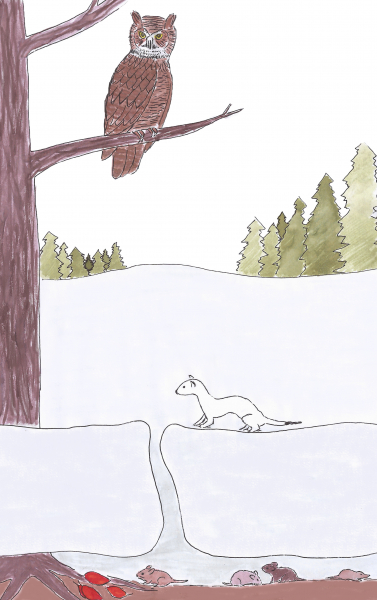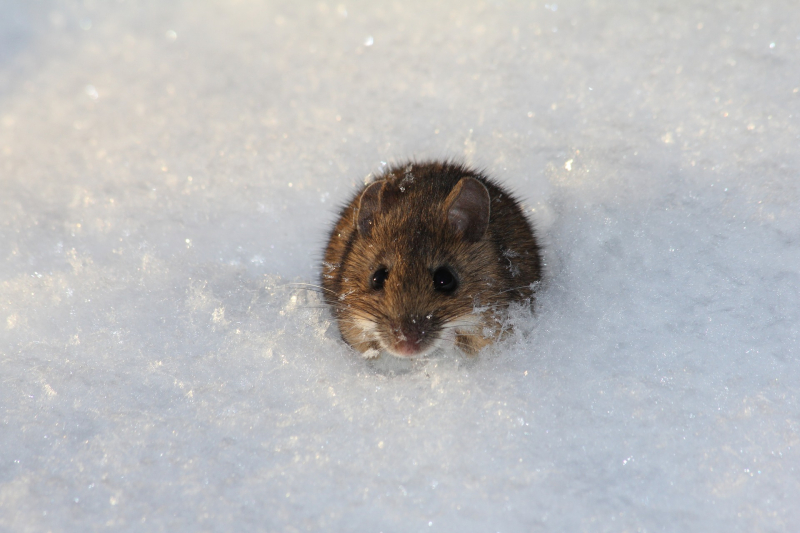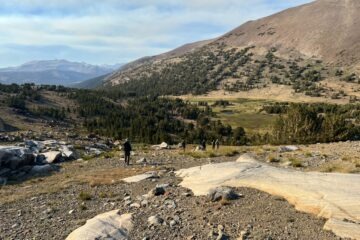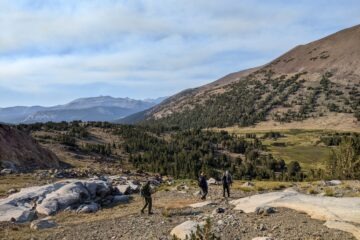Snow has been falling for a few days, burying meadow grasses and long-fallen leaves under a thick white quilt. You’re walking through the powder on a frigid day, shoulders shivering and stomach rumbling, when you notice a hole in the snow, just big enough for you to drop into. You take a chance on curiosity and slide down into the snowpack, landing on bare earth. The light from the opening fades as you start moving through what seems like a sturdy tunnel, letting yourself relax in the noticeably warmer air. You round a corner, and come across a welcome sight: a stash of snacks!
What is this marvelous place? you murmur to yourself, munching away on savory seeds. Alice’s Wonderland?
 Not quite. That below-snow haven is the subnivean zone, a very real facet of winter life for many mammals. Of course, you wouldn’t be able to slip into the subnivean zone without the help of Alice’s “drink me” potion to shrink you down to the size of a mouse, but it’s fun to imagine what it would be like to navigate the world under the snow!
Not quite. That below-snow haven is the subnivean zone, a very real facet of winter life for many mammals. Of course, you wouldn’t be able to slip into the subnivean zone without the help of Alice’s “drink me” potion to shrink you down to the size of a mouse, but it’s fun to imagine what it would be like to navigate the world under the snow!
“Subnivean” zone – from the Latin for under and snow – refers to the small space between the ground and the bottom of the snowpack. As snow piles up, heat from the ground warms the lowest layer of flakes, transforming them into water vapor. The vapor freezes, creating a cozy winter home: icy roof above, bare ground below. Subnivean spaces can also form when tree branches, leaf piles and other natural objects hold snow off the ground.
We often talk about snow “blanketing” the earth – for some of Yosemite’s smallest animals, including mice, voles and shrews, that’s not just a nice turn of phrase. As animals around them head south, nestle into dens or don their cold-weather coats, another group of creatures moves into a wild, bustling winter world that remains, for the most part, out of our view. For them, the layer of snow above their subnivean hollows serves as an insulating, and essential, quilt, blocking out the wind and keeping below-snow temperatures at around a relatively balmy 32 degrees Fahrenheit.
Throughout the winter, subnivean-dwelling mammals move through a network of snow-covered tunnels, snacking on leaves, seeds and bark, or feasting on insect eggs and larvae. Some animals stockpile sustenance in preparation for winter, while others take a more spontaneous approach, eating what they can find. Holes connecting the tunnels to the surface provide vital ventilation, allowing carbon dioxide to escape.
 To the human senses, the subnivean zone is nearly invisible. We might spot tiny tracks leading to small entrance holes or see the remnants of icy-roofed tunnels as the snow starts to melt, but usually the bustling sub-snow ecosystem eludes our notice.
To the human senses, the subnivean zone is nearly invisible. We might spot tiny tracks leading to small entrance holes or see the remnants of icy-roofed tunnels as the snow starts to melt, but usually the bustling sub-snow ecosystem eludes our notice.
For the animals that depend on subnivean life for survival, however, that winter world is a constant focal point. Coyotes listen for subtle movements in blanketed meadows; when they sense potential prey scurrying underfoot, they plunge headfirst into the snow to nab their meal. Owls. too, use their extraordinary hearing to listen for tiny feet pattering through subnivean tunnels, then swoop down to scoop up their quarry. Short-tailed weasels, which sport a brown coat in warm months but wear white in winter, take advantage of their small size and snow-colored camouflage to slide into subnivean tunnels and hunt below the snow.

Despite the ever-present danger of becoming someone else’s meal, the subnivean zone offers its residents benefits they’d miss on the surface. Small mammals lose heat more quickly than larger animals, and can’t bear the weight of insulating winter coats like the ones that keep their predators warm. In the insulated subnivean zone, though, they can take advantage of a stable, relatively temperate climate; easy access to food that would otherwise be out of reach; and space to sleep, sometimes snuggled up with fellow critters, out of sight.
Life below the snow offers some comforts to small creatures, but it’s not always a walk (or scurry) in the park. In addition to predation, subnivean denizens face unpredictable hazards, such as collapsed tunnels, suffocation and flooding. Still, for animals that can’t migrate south or handle extreme weather on the surface, it’s prime real estate!
The next time you’re hiking in a snow-covered area, look for hints of life underfoot, such as tiny tracks leading to small holes in the surface, or coyotes staring intently at apparently empty patches of snow. Stick to trails when you can, and tread lightly – you never know whose roof you’re walking on.
Whenever you’re in the park, in any season, do your part to protect wildlife of all sizes: Drive slowly and alertly, store your food securely, and observe animals from a distance. Want to learn more about and support Yosemite ecosystems? Join us for an Outdoor or Custom Adventure with an expert naturalist, and browse our current grants for habitat restoration, wildlife management, scientific research and more!
Above: Snow piles up along Yosemite’s Glacier Point Road in the winter. The subnivean zone typically requires at least six inches of snow to form. Photo: Carolyn Botell, January 2019.



